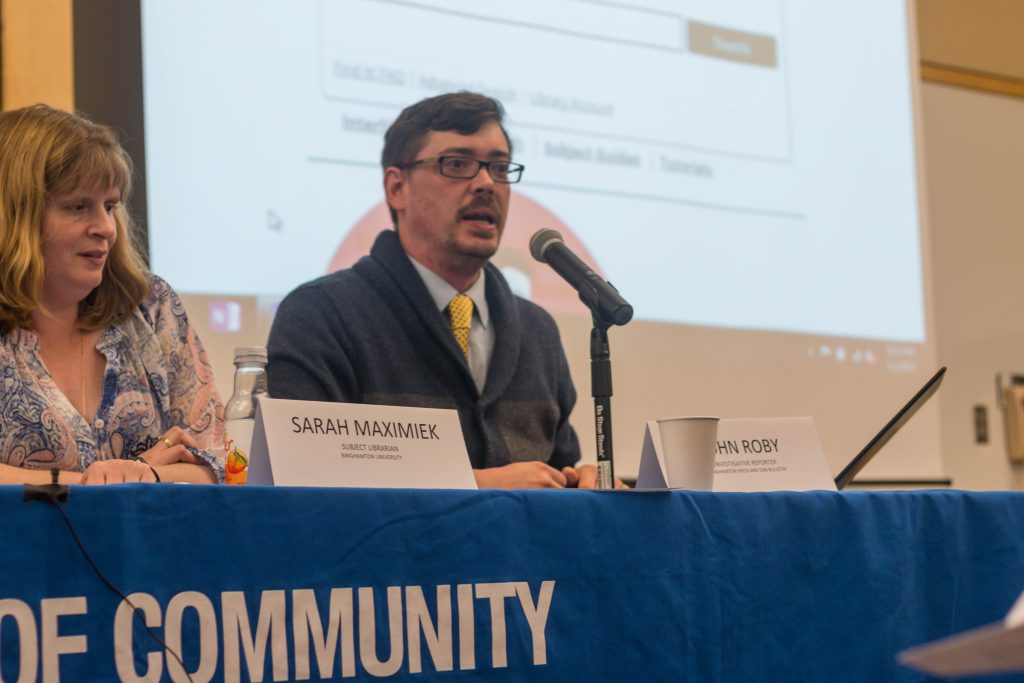As the popular adage goes: a lie travels around the world while the truth is putting on its shoes. To share tips on distinguishing false information from accurate news, a panel of local media professionals spoke at a seminar titled “How to be a Truth Seeker” Tuesday evening at the University Downtown Center.
Since last year’s presidential campaign, “fake news” and “alternative facts” have become household terms. According to panelist Sarah Maximiek, a subject librarian at Binghamton University, there are simple ways to determine whether an article’s claims are legitimate, including researching the date of publication, any referenced sources and most importantly, the author.
“See if the author knows anything about what they’re writing or if they’re just some guy in a basement,” Maximiek said.
Maximiek said there are three categories of fake news: fake news, which is based on inaccurate or untrue information; biased news, which is based in fact but has a definite spin in one direction; and satire news, which can be found in sources like The Onion.
She stressed the value of acquiring news from multiple, varied outlets.
“The more diverse your news sources are, the more points of view you’re getting on every story,” she said.
John Roby, an investigative reporter for the Press & Sun-Bulletin, the Binghamton area’s largest daily newspaper, said that a key to determining a story’s credibility is developing a “data state of mind.”
“When you want to check out the veracity of something, my advice is always go to the data,” he said.
Roby cited publicly available resources such as the Federal Bureau of Investigation’s yearly data on index crimes, which account for the eight most common violent and nonviolent crimes in the United States. He suggested seeking out data that can support or refute a given claim, but remaining aware of the type of information and the context in which it was collected.
“The data that you look at is only as good as the methods used to collect them,” Roby said. “Every data set has some strength and some limitations. Is the data you’re looking at actually answering the question you want answered?”
For Bob Joseph, a panelist and WNBF talk show host, researching often comes on the fly when trying to verify statements made by the guests of his show.
“It’s working without a safety net,” Joseph said. “My net is a seven-second digital delay, which doesn’t give me a lot of cushion. If someone says something and it’s completely erroneous and I haven’t challenged it, I have failed to a degree.”
Joseph’s regular guests include Binghamton Mayor Rich David and Broome County Executive Jason Garnar, who are tasked with answering questions from the public in a live and unedited format. He said that it’s important for elected officials to routinely be held accountable by their constituents.
He also noted the susceptibility of media outlets to make mistakes in their reporting or have an underlying agenda.
“Every reputable news organization, from time to time, has had problems because we employ humans,” Joseph said. “News organizations have to admit they’ve made errors and everybody has to really work to maintain, and in some cases, re-earn credibility.”
Following the discussion, which was co-sponsored by the Press & Sun-Bulletin, Binghamton University’s College of Community and Public Affairs and its department of public administration, the approximately 100 attendees were able to direct questions at each speaker.
Tony Burshnick, an accountant and city of Binghamton resident, said he came to the event to learn more about the information he was already receiving.
“I’m reasonably well-informed already, but there are some holes in my data, so I wanted the chance to find out more about what’s going on, especially locally,” he said.
Burshnick said a commitment to challenging what one is told is imperative, especially in the current political climate.
“Trying to ferret out the truth is difficult, but you can’t stop asking questions,” he said. “Don’t ever stop searching because there’s always more information out there.”



